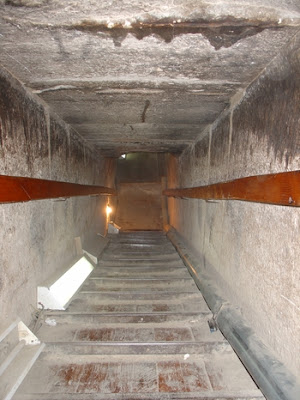 |
| Inside Pyramid of Khufu |
This was not always the case, and at one time there was an official guide dubbed the “Acrobat King of the Pyramids.” A slightly built man, Nefnawi Faid is now around fifty years old, but he is still famous for holding the record for the shortest time in scaling the Great Pyramid of Cheops—an amazing five minutes and thirty seconds to the top and back again. Nefnawi Faid first climbed the Pyramid when he was twenty-six. His performance came to be famous and his scaling of it became the regular conclusion to a visit to Cheops’s tomb. Born in the nearby village of Mena, the Pyramids were his life. Heads of state and senior government officials on state visits have stood amid the crowds and shouted encouragement to the little man. A list of his excited cheerers would read like an international Who’s Who— Nasser, Nehru, Sukarno, Chou En-Lai and Aneurin Bevan. When Khrushchev saw the performance he presented him with a gold watch. Yugoslavia’s Tito, on witnessing it, gave him a gold cigarette case. King Faisal, a monarch rarely moved by anything, watched the performance with a look of disbelief on his face, and when Faid reached the ground he is said to have surprised him with 1,000 Egyptian pounds (approximately U.S. $2,500) on the spot. In his climb to the top of the Pyramid, Faid faced danger daily and never knew whether he would see another tomorrow. And so the story goes that when Faid received the generous present from King Faisal, he promptly announced that he would be taking a holiday and go drinking with his friends until all the money was gone!
Apparently, the secret of climbing a pyramid is not to do it in a straight line, but to zigzag up a side. Balance is extremely important, and it is vital to concentrate every second. Whatever happens, one must not be distracted from the climb.
When he married and settled down to become a family man in 1973, Faid began to think that it was time to give up the dangerous climb. The government at that time issued an order prohibiting the climbing of pyramids. As a result, Nixon, and later Kissinger, on their visits to Egypt were denied the opportunity of witnessing Faid’s skill and speed. Glancing from his gold watch to the top of the Pyramids, Faid is not above musing about the “good old days.”
 |
| Inside Pyramid of Khufu |
At the time it was built, Cheops Pyramids was 480 feet high. But it has been eroded to 450 feet. The top does not come to a point, but is square and flat. Originally it was only 10 feet square, but the effects of erosion have taken their toll and the top now measures 33 feet square.
What sort of man was Cheops to have had at his disposal the organization and technical skill required to construct these great masses of stone? Some say he was a powerful and cruel tyrant who sought only personal glory. But perhaps the masses who actually built the Pyramids were content with the belief that participation in the construction of the monument for the king’s “life after death” would secure them a small corner in that same world.
Southwest of Cheops’ Pyramid stand the other two Great Pyramids of Chephen and Mycerinus. The Great Sphinx is located a little to the east of them. The Sphinx, its face the face of the ruler Chephen and its body that of a lion, gazes over the desert typifying everything that was Egypt in the days of the Pharaohs.









 Posted in:
Posted in: 

0 comments:
Post a Comment